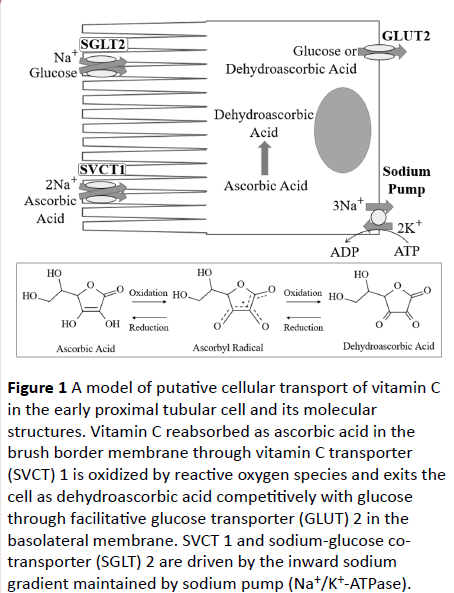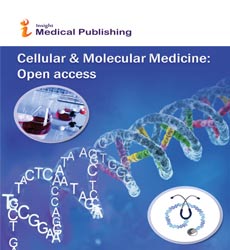Sodium-Glucose Co-Transporter 2 Inhibitors could Improve the Bioavailability of Vitamin C at the Kidney in Diabetes Treatment
DOI10.21767/2573-5365.100030
Yuji Aoki1*, Masato Aoki2 and David JA Jenkins3
1Department of Internal Medicine, National Hospital Organization Matsumoto Medical Center Matsumoto Hospital, Matsumoto, Nagano 3998701, Japan
2Matsumoto University Graduate School of Health Science, Matsumoto, Nagano 3901295, Japan
3Department of Nutritional Sciences, University of Toronto, Toronto, ON M5S 3E2, Canada
- *Corresponding Author:
- Yuji Aoki
Department of Internal Medicine, National Hospital Organization Matsumoto Medical Center Matsumoto Hospital, 2-20-30 Minami Murai, Matsumoto, Nagano 3998701, Japan
Tel: 810263584567
Fax: 810263863183
E-mail: yaoki55@nifty.com
Received date: May 03, 2017; Accepted date: May 16, 2017; Published date: May 22, 2017
Citation: Aoki Y, Aoki M, Jenkins DJA. Sodium-glucose co-transporter 2 inhibitors could improve the bioavailability of vitamin C at the kidney in diabetes treatment. Cell Mol Med 2017, 3:2.
Abstract
It is known that plasma (serum) vitamin C level is lowered in diabetic patients by some mechanisms including renal loss [1]. Vitamin C and glucose filtered from the glomerulus are presumed to be reabsorbed at the renal proximal tubule by sodium-vitamin C co-transporter (SVCT) 1 and sodium-glucose co-transporter (SGLT) 2, respectively [2-4]. In the enterocyte that expresses SVCT 1 and SGLT 1, it was demonstrated in vitro that cellular uptake of vitamin C was inhibited by increasing concentrations of glucose in medium, which was not observed at the presence of phlorizin, a non-specific SGLT inhibitor [2]. If such an effect is applied to renal proximal tubular cells, it is hypothesized that SGLT 2 inhibitors can improve the bioavailability of vitamin C in diabetes treatment.
Letter to Editor
It is known that plasma (serum) vitamin C level is lowered in diabetic patients by some mechanisms including renal loss [1]. Vitamin C and glucose filtered from the glomerulus are presumed to be reabsorbed at the renal proximal tubule by sodium-vitamin C co-transporter (SVCT) 1 and sodium-glucose co-transporter (SGLT) 2, respectively [2-4]. In the enterocyte that expresses SVCT 1 and SGLT 1, it was demonstrated in vitro that cellular uptake of vitamin C was inhibited by increasing concentrations of glucose in medium, which was not observed at the presence of phlorizin, a non-specific SGLT inhibitor [2]. If such an effect is applied to renal proximal tubular cells, it is hypothesized that SGLT 2 inhibitors can improve the bioavailability of vitamin C in diabetes treatment.
In two cases of diabetic patients treated with empagliflozin, a SGLT 2 inhibitor, in hospitalization, their serum vitamin C levels (normal reference range, 5.5 μg/ml to 16.8 μg/ml) have been observed to increase soon after its administration. In a male patient newly diagnosed with type 2 diabetes (HbA1c, 13.4 %) at age 41 (174 cm, 114 kg), his serum vitamin C level changed from 7.2 μg/ml to 8.1 μg/ml two days after adding 10 mg empagliflozin on 1000 mg metformin. Urinary glucose excretion increased from 15.5 g/day to 148.1 g/day. In a female patient with 12-year duration of type 2 diabetes (HbA1c, 7.4%) and renal insufficiency (serum creatinine, 1.64 mg/dl) at age 67 (155 cm, 99 kg), her serum vitamin C level changed from 7.9 μg/ml to 8.5 μg/ml twelve days after adding 10 mg empagliflozin on 5 mg Linagliptin. Urinary glucose excretion increased from 2.9 g/day to 23.8 g/day. Ascorbic acid, a reduced form of vitamin C, or glucose enters cells specifically through SVCT or SGLT, driven by the inward sodium gradient maintained with sodium pump (Na+/K+-ATPase). Dehydroascorbic acid, an oxidized form of vitamin C, enters or exits cells competitively with glucose through facilitative glucose transporters (GLUTs) [3,5]. Taken together, a model of putative cellular transport of vitamin C in the early proximal tubular cells is drawn in Figure 1.
Figure 1 A model of putative cellular transport of vitamin C in the early proximal tubular cell and its molecular structures. Vitamin C reabsorbed as ascorbic acid in the brush border membrane through vitamin C transporter (SVCT) 1 is oxidized by reactive oxygen species and exits the cell as dehydroascorbic acid competitively with glucose through facilitative glucose transporter (GLUT) 2 in the basolateral membrane. SVCT 1 and sodium-glucose cotransporter (SGLT) 2 are driven by the inward sodium gradient maintained by sodium pump (Na+/K+-ATPase).
Ascorbic acid reabsorbed at the brush border membrane through SVCT 1 is oxidized by reactive oxygen species, and exits the cell as dehydroascorbic acid competitively with glucose through GLUT 2 at the basolateral membrane. In this model, the reabsorption of dehydroascorbic acid at the brush border and the exit of ascorbic acid at the basolateral membrane are assumed to be negligible. At the presence of SGLT 2 inhibitors, the reabsorption of ascorbic acid could be increased by utilizing the energy saved by the inhibition of SGLT 2 [4]. The inhibition of glucose reabsorption could also lead to increasing the exit of dehydroascorbic acid through GLUT 2 by becoming less competitive with glucose. Under the reducing and neutral pH conditions in the bloodstream, almost all vitamin C exists as ascorbic acid (precisely as ascorbate) [6]. It seems plausible that reabsorbed ascorbic acid protects renal proximal tubular cells from reactive oxygen species and exits the cells as dehydroascorbic acid, as indicated in the neurons [7]. If this hypothesis is verified, SGLT2 inhibitors would be expected to have beneficial effects on the kidney beyond glucose lowering [4,8].
References
- Seghieri G, Martinoli L, Miceli M, Ciuti M, D’Alessandri G, et al. (1994) Renal excretion of ascorbic acid in insulin dependent diabetes mellitus. Int J Vitam Nutr Res 64: 119-124
- Malo C, Wilson JX (2000) Glucose modulates vitamin C transport in adult human small intestinal brush border membrane vesicles. J Nutr 130: 63-69.
- Li Y, Schellhorn (2007) New developments and novel therapeutic perspectives for vitamin C. J Nutr 137: 2171-2184.
- Aoki Y (2016) Comparison of diuretic effects between empagliflozin, a sodium-glucose co-transporter 2 inhibitor with osmotic diuresis, and tolvaptan, a water diuretic, in two type 2 diabetic patients taking sodium diuretics. Diabetes Res Open J 1: 72-74.
- Corpe CP, Eck P, Wang J, Al-Hasani H, Levine M (2013) Intestinal dehydroascorbic acid (DHA) transport mediated by the facilitative sugar transporters, GLUT2 and GLUT8. J Biol Chem 288: 9092-9101.
- Robitaille L, Hoffer LJ (2016) A simple method for plasma total vitamin C analysis suitable for routine clinical laboratory use. Nutr J 15: 40.
- Nualart F, Mack L, Garcia A, Cisternas P, Bongarzone ER, et al. (2014) Vitamin C transporters, recycling and the bystander effect in the nervous system: SVCT2 versus Gluts. J Stem Cell Res Ther 4: 209.
- Wanner C, Inzucchi SE, Lachin JM, Fitchett D, von Eynatten M, et al. (2016) Empagliflozin and progression of kidney disease in type 2 diabetes. N Engl J Med 375: 323-334.
Open Access Journals
- Aquaculture & Veterinary Science
- Chemistry & Chemical Sciences
- Clinical Sciences
- Engineering
- General Science
- Genetics & Molecular Biology
- Health Care & Nursing
- Immunology & Microbiology
- Materials Science
- Mathematics & Physics
- Medical Sciences
- Neurology & Psychiatry
- Oncology & Cancer Science
- Pharmaceutical Sciences

